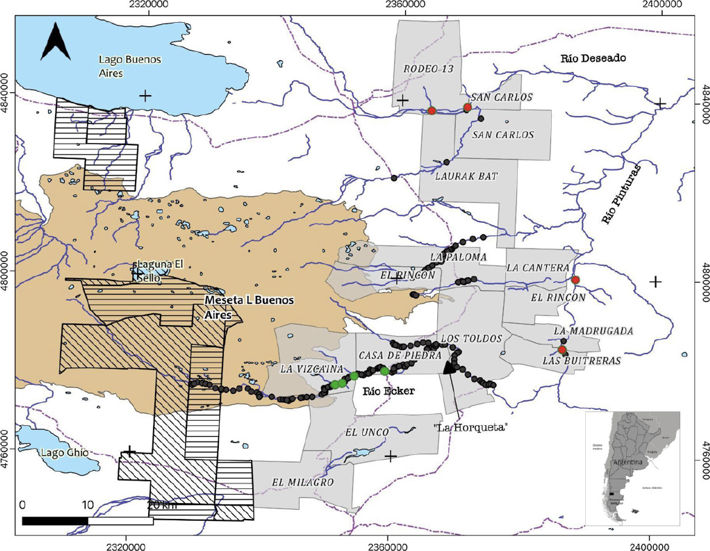El coipo (Myocastor coypus) en el noroeste de Santa Cruz (República Argentina): ¿Evidencias de recuperación por el control del visón americano (Neogale vison)?
DOI:
https://doi.org/10.31687/saremNMS.22.1.1Keywords:
American mink, coypu, invasive species, management, southern PatagoniaAbstract
The coypu Myocastor coypus is widely distributed in Argentina. In southern Patagonia the subspecies M. c. melanops is associated to large wetlands and river valleys. Although hunting has been recognized as one of the causes of population decline at a regional level, the American mink Neogale vison has been also mentioned as a threat. Through monitoring (more than 7,000 hours of observations) and interviews with local inhabitants of the upper basin of the Deseado River (12 estancias), northwestern Santa Cruz Province, Argentina, we examine the potential causes of population recovery. The results suggest that the evident recovery in this basin seems to be due to two main factors: the reduction of hunting pressure, and the American mink control plan that has been carried out since 2013. It is essential to consider and analyze the threats, in order to carry out management actions of great impact for the communities.
References
Aars, J., X. Lambin, R. Denny, & A. Griffin. 2001. Water vole in the Scottish uplands: distribution patterns of disturbed and pristine populations ahead and behind the American mink invasion front. Animal Conservation 4:187–194.
Arim, M., S. R. Abades, P. E. Neill, M. Lima, & P. A. Marquet. 2006. Spread dynamics of invasive species. Proceedings of the National Academy of Sciences of the United States of America 103:374–78.
Barreto, G. R., Rushton, S. P., Strachan, R., & D. W. Macdonald. 1998. The role of habitat and mink predation in determining the status and distribution of declining populations of water voles in England. Animal Conservation 1:129–137.
Canevari, M., & O. Vaccaro. 2007. Guía de mamíferos del sur de América del Sur. L.O.L.A., Buenos Aires.
de Miguel, A., L. Fasola, I. Roesler, L. B. Martín, N. Cossa, & E. Giusti. 2019. Ecological requirements and relative impact of threats affecting the Austral Rail Rallus antarcticus: monitoring methodology considerations for an imperative conservation status re-evaluation. Bird Conservation International 29:586–597.
Fasola, L. 2009. Distribución, alimentación e interacciones de dos mustélidos semi-acuáticos en los bosques andino patagónicos: el Huillín (Lontra provocax), nativo, y el Visón Americano (Mustela vison), introducido. Tesis de doctorado. Universidad de Buenos Aires, Buenos Aires, Argentina.
Fasola, L., J. Muzio, C. Chehébar, M. Cassini, & D. W. Macdonald. 2010. Range expansion and prey use of American mink in Argentinean Patagonia: dilemmas for conservation. European Journal of Wildlife Research 57:283–294.
Fasola, L., & I. Roesler. 2016. Invasive predator control program in Austral Patagonia for endangered bird conservation. European Journal of Wildlife Research 62:601–608.
Fasola, L., & I. Roesler. 2018. A familiar face with a novel behavior raises challenges for conservation: American mink in arid Patagonia and a critically endangered bird. Biological Conservation 218:217–222.
Fasola, L., P. Zucolillo, I. Roesler, & J. L. Cabello. 2021. Foreign Carnivore: the case of American Mink (Neovison vison) in South America. Biological Invasions in the South American Anthropocene (F. M. Jaksic & S. A. Castro, eds.). Springer Nature, Suiza.
Foerster, R. 1973. Estudio integral sobre la presencia de visones (Mustela vison) en el Parque Nacional los Alerces y zona de influencia. Reporte técnico, Centro de Documentación, Administración de Parques Nacionales, Argentina.
Galende, G. I., A. Troncoso, & S. A. Lambertucci. 2013. Effects of coypu (Myocastor coypus) abundances and diet selection on a wetland of the Patagonian steppe. Studies on Neotropical Fauna and Environment 48:32–39.
Jaksic, F. M., & S. A. Castro. 2021. Biological Invasions in the South American Anthropocene. Global Causes and Local Impacts. Springer Nature, Suiza.
Macdonald, D. W., & L. A. Harrington. 2003. The American Mink: the triumph and tragedy of adaptation out of context. New Zealand Journal of Zoology 30:421–41.
Macdonald, D. W., & R. Stratchan. 2002. The mink and the water vole: Analyses for conservation. WildCRU, Oxford.
Mazar Barnett, J., S. Imberti, & I. Roesler. 2014. Distribution and habitat use of the Austral Rail Rallus antarcticus and perspectives on its conservation. Bird Conservation International 24:114–125.
Moorhouse, T. P., M. Gelling, & D. W. Macdonald. 2009. Effects of habitat quality upon reintroduction success in Water Voles: evidence from a replicated experiment. Biological Conservation 142:53–60.
Pagnoni G., J. Garrido, & M. Marin. 1986. Impacto económico y ambiental del visón Mustela vison (Schreber 1877) en el norte de la Patagonia. Reporte técnico, CENPAT–CONICET, Dirección de Fauna de la Provincia de Chubut, Puerto Madryn.
Parera, A. 2018. Los mamíferos de la Argentina y la región austral de Sudamérica. AP Ediciones, Buenos Aires.
Porini, G., R. F. Bó, M. L. Guichón, M. J. Corriale, P. Courtalón, & M. L. Bolkovic. 2019. Myocastor coypus. Categorización 2019 de los mamíferos de Argentina según su riesgo de extinción. Lista Roja de los mamíferos de Argentina (SAyDS–SAREM, eds.). <http://cma.sarem.org.ar>.
Vargas Jiménez, I. 2012. La entrevista en la investigación cualitativa: nuevas tendencias y retos. Revista Calidad en la Educación Superior 3:119–139.

Downloads
Published
How to Cite
Issue
Section
License
Copyright (c) 2022 Patrick I. Buchanan, Laura Fasola, Ignacio Roesler

This work is licensed under a Creative Commons Attribution-NonCommercial 4.0 International License.

